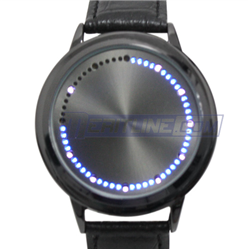Logic and Emotion in the Design of a Watch
 The moment I saw this watch I was in love. Not with the watch itself, but with what it taught me the moment I saw it.
The moment I saw this watch I was in love. Not with the watch itself, but with what it taught me the moment I saw it.
The lights around the perimeter reminded me that minutes are not just minutes – they are usually an emotional experience. Take two people, one wears a watch, the other uses their phone for the time. Most people say they tell time differently, but I don’t think so. They both interpret number or hands to mean the same thing. But even more so, that interpretation is then interpreted into, “I have 7 minutes until I am late for my next meeting,” or “We have been waiting for dinner service for 12 minutes so far and only have our drinks.” The minutes are instantly translated into an an experience where we add emotion.
So this watch, with the lights, displayed to me that emotion. As the lights make it around the circle (at about 44 minutes as shown) I instantly know that I have about 15 minutes until the movie starts. And I think the word “ABOUT” is crucial. Many times it is not necessary to know exactly how many minutes are left, only a good estimate because what it means (we are late, or anticipating something) is much more than the exact number of minutes left.
The hour, however, is more logic. We don’t tie emotion to the hour (for the most part). We normally know what the hour is already. To have the hour in lights (as displayed above) didn’t make sense. I would want a logic (hour) and emotional (minute) interface that plays to the way I use and interact with time.
 This watch below would be the perfect mix. Normally we ignore the hour, yet the lights give a count-down effect that plays to our emotions.
This watch below would be the perfect mix. Normally we ignore the hour, yet the lights give a count-down effect that plays to our emotions.
Watches with hands are all emotions. Analog watches are all logic. Mix them together and you are designing each to why we humans are interested in the time of day.
